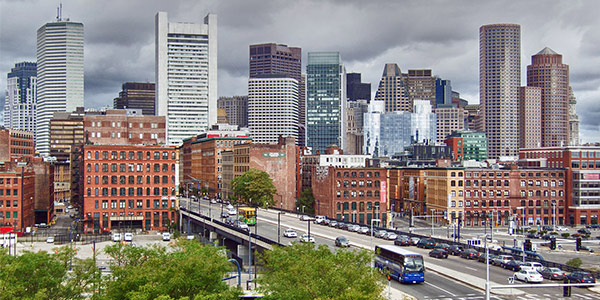Massachusetts Gov. Charlie Baker returned a comprehensive climate bill to the state legislature Sunday, with amendments that would lower the bill’s 2030 interim emissions reduction goal of 50% below 1990 levels to as low as 45%.
“Over the past three weeks, our administration has engaged in productive and informative discussion with members of the House and the Senate and various stakeholders, and we have been able to find considerable common ground,” Baker wrote in a letter to the legislature with his proposed amendments.
The bill maps a plan for Massachusetts to reduce emissions 85% below 1990 levels by 2050, with interim targets of 50% by 2030 and 75% by 2040. It also places emissions limits on state power sectors, allows for an additional 2,400 MW purchase of offshore wind power, establishes appliance energy efficiency standards and codifies public process engagement requirements for environmental justice communities.
Baker vetoed an identical bill in early January, saying he didn’t have time to review it at the end of the legislative session. Lawmakers passed the bill again on Jan. 28.
Baker expressed support in his letter for increasing Massachusetts’s OSW energy procurements.
“We recognize that more work is needed to ramp up offshore wind development in Massachusetts and to provide clean, affordable power to residents,” Baker wrote in the letter.
But the governor called for the executive branch to set a range of reduction from 1990 emissions levels between a 45% and 50% as an interim goal for 2030.
Baker similarly proposes that the executive branch be allowed to set the 2040 target between 65% and 75%.
The governor said in a previous letter to the legislature that a state analysis found it would cost $6 billion more to reduce carbon emissions by 50% in such a short timeframe compared to a 45% reduction.
Allowing the executive branch to determine the final target, he said, would ensure it reflects “the best available data and any changed circumstances that may make a more aggressive interim limit feasible and appropriate.”
The drop from 50% to 45% in emissions reductions makes “a meaningful difference in how fast we can go” when it comes to the transition to net zero, Craig Altemose, executive director of the Better Future Project, told RTO Insider.
Ben Hellerstein, state director for Environment Massachusetts, said in a statement that the governor’s message to the legislature “is a mixed bag.”
“He supports some of the bill’s most important provisions as is, while asking legislators to weaken others,” he said. “Legislators should reject any weakening amendments, and, most important, they should act quickly to pass this bill into law.”
If the legislature passes the bill with changes, it will be sent to Baker for approval. The governor will not be able to offer further amendments. If he vetoes the bill, the House and Senate both have the votes needed for an override.
Emissions Limits for Industry
The climate bill also establishes emissions sublimits for certain sectors. Baker is asking lawmakers to allow those sublimits to serve as planning tools for Massachusetts businesses and industries instead of legal requirements, “provided we achieve our overall statewide emissions reductions.”
In vetoing the climate bill in January, Baker expressed concerns that pieces of the legislation would impede affordable housing construction by creating a new source of construction costs and delays if cities and towns had the authority to ban new natural gas hookups for newly constructed buildings.
Baker suggested amendments to the requirement that the Department of Energy Resources “develop and adopt, as an appendix to the state building code, in consultation with the board of building regulations and standards, a municipal opt-in specialized stretch energy code that includes, but is not limited to, a definition of net-zero building.” He said his changes would provide clarity on what the code should focus on to avoid cost pressures on new affordable housing units.
The governor said the amendments would clarify that the existing stretch energy code under his office’s own climate plan will be shifted under the control of Department of Energy Resources (DOER) as a “specialized stretch energy code,” and that DOER will promulgate an “updated stretch energy code that includes a municipal option for high-performing, energy-efficient new construction that supports our emissions reduction goals” after a regulatory process with “significant” stakeholder input.
“The Interim Clean Energy and Climate Plan for 2030 calls for a high-performance stretch energy code to be available for municipal opt-in by 2022 and allows six years for full adoption statewide by 2028,” the governor wrote.
Development lobbyist NAOIP Massachusetts, the Greater Boston Chamber of Commerce and the Home Builders and Remodelers Association of Massachusetts urged Baker to veto the climate bill in January, citing concerns about the cost of the transition for homeowners.



